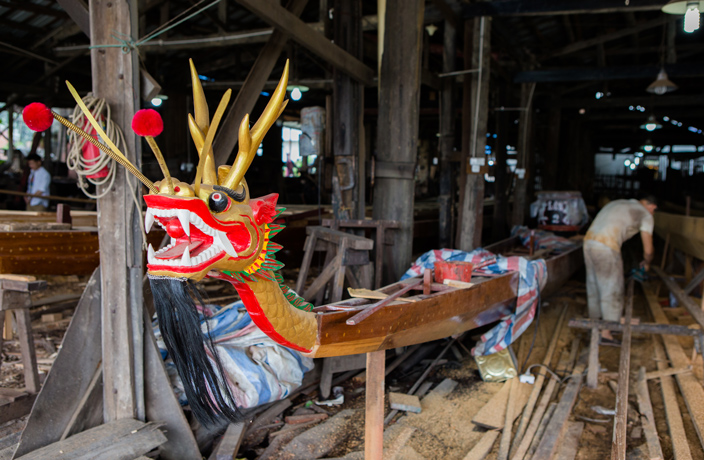Sawdust clings to every surface in the room. The air is thick with suspended particles, making it difficult to inhale. Carpenters toil side by side, shaping long planks and miniature pegs from slabs of timber. Craftsmen kneel on mounds of soft shavings, measuring the hull’s bottom.
In a shabby workshop at the end of a remote country road in Shangjiao village, in Guangzhou's Panyu District, new boats are handcrafted while old ones are repaired and polished. A few weeks from now, the Chen Hanghui Dragon Boat Base – one of the oldest manufacturers in the region – must deliver the boats to nearby villages, which will compete against each other during the annual Duanwu Festival. Workers are too busy to talk, eyes silently pleading us to return another season.
A dozen workshops, or rather shacks supported by wooden beams, occupy the shore of a narrow stream branching off from the river. When completed, the dragon boats can be delivered to each village by water.
Watching the process, it’s clear the mechanics of dragon boat assembly haven’t evolved much over the past century – probably because they don’t need to.
As the center of Guangdong's dragon boat artistry for more than 140 years, Shangjiao village has raised generations of skilled boat craftsman.
“[Chen Hanghui base] contributes around 90 percent of all dragon boats produced in Guangdong province,” boasts Chen Weijie, publicity manager of Shangjiao village’s governing committee.

The trademark ‘made in Panyu’ was once revered throughout China and the world as a sign of quality. In the mid 20th century, handcrafted boats were in high demand and sold to Hong Kong, Southeast Asia and even South Africa.
To make a 40-meter-long dragon boat out of a pile of timber, 13 steps are followed precisely as they were 100 years ago. Six craftsmen work for 20 days, hammering more than 50 kilograms of nails into the vessel, according to Lu Haoying, a dragon boat craftsman who's been in the trade more than 50 years.
But Lu shut down his workshop two years ago, opting to make miniature dragon boats for decoration instead.
“Most workshops are now owned by private contractors,” says Li Xiang, another veteran dragon boat shifu. Even with 30 years of experience, Li only receives RMB250 for a physically taxing seven-hour workday, with a bonus of RMB125 per day during busy months. He tells us the village used to house more than 20 workshops, but more than half of them have closed in recent years due to dwindling demand.
Traditionally, dragon boats were crafted from teak wood (which is now priced at RMB14,500 per cubic meter) and giam, a type of timber imported from Indonesia, Malaysia and Myanmar. Teak wood boats can be used for more than 50 years, provided they receive regular maintenance.
“A 40-meter-long boat made of teak wood costs about RMB270,000,” Li shouts over a symphony of shrieking electric saws behind him. He says the factory has received 10 orders so far this year, most of which come from outside of the PRD, in places like Yangjiang, Taishan, Haifeng and Lufeng.

In 1976, the first international dragon boat competition in Hong Kong raised the curtain of modernization and standardization on this once regional sport. Dragon boat racing, traditionally held during Duanwu Festival, was previously observed in water-bound regions of China (mainly Guangdong), Vietnam, Indonesia and the then Ryukyu Kingdom.
Nowadays, boats used in professional competitions are made of carbon fiber, fiberglass and other lightweight materials. The market for traditional wooden boats, therefore, has shrunk significantly.
When asked whether they are worried about the future of traditional boat craftsmanship, both Lu and Li sound optimistic.
“There are always people like us who appreciate [the boat’s] beauty,” Lu declares. “As long as the tradition of the Duanwu Festival remains, the techniques of handcrafting dragon boats will be passed on.”
The history of dragon boat racing is believed to stretch back over two millennia to the time of the original Olympic games. Yet modern racing didn’t take shape until the late 1970s, when the Hong Kong Tourism Board used the sport to promote the country’s image abroad.
Following the Hong Kong International Dragon Boat Races of 1976, dragon boats were gifted to each competing team, paving the way for the creation of new racing associations.
Today, the International Dragon Boat Federation (IDBF), as well as the European (EDBF) and Asian (ADBF) divisions are the three main bodies that organize international events.
The Pearl River Delta has played a significant role in the development of the sport, both by manufacturing vessels for export and by cultivating a competitive spirit among paddlers in the region.

When David Butler of the UK joined the Guangzhou International Dragon Boat Team in 2010 through its former general manager Kalok Li, it was a small group comprised of mostly locals. After Li left the club last year, Butler took over as general manager and worked with its president, Vega Hui, to recruit more expat members. Today, the team has expanded to include a committed international crew. The rowers, half of which are female, hail from China, Australia, France, Britain, Jordan, Malaysia and Thailand, to name a few.
Butler and his crew are regularly invited to races in Guangdong every year around the time of the Duanwu Festival. Lesser-known cities like Huizhou, Shaoguan, Zhanjiang and Zhaoqin have all seen the team’s zest on the water, not to mention Guangzhou and Foshan.
As the team gains acclaim in South China, they’re also beginning to receive invitations to international competitions in Hong Kong, Malaysia, Thailand, the Philippines and South Korea.
“When competing overseas, we’re often the only team flying the flag of China, even though we’re a mixed bunch of international paddlers,” says Butler. He feels honored to represent China, where dragon boat racing originated, in competitions abroad.
Four members of the Guangzhou International Dragon Boat Team recently competed in the 2016 Club Crew World Championships, held by IDBF in Adelaide, Australia. They hope to one day bring their entire Guangzhou team to compete in the world cup.

“The social side of dragon boat racing is important,” explains Butler. “After the races, we usually have a banquet or celebration and hold a performance, like a dance or short skit. Months before the competition, we’re on the water regularly to perfect our technique. And then, a few days before the race, we get together again to rehearse our dance routine as well."
For Butler and his teammates, dragon boat racing is a comprehensive exercise that develops one’s strength, stamina and fitness. It also allows expat members to explore the Pearl River and surrounding region, which has inspired them to raise awareness about the river’s pollution.
Recently, the crew invited a number of Chinese companies and schools to send staff members for training in order to help establish new recreational dragon boat teams.
This October, the Guangzhou squad will venture all the way to Egypt to compete in a race along the Nile. Organized by the Egyptian Friendship Association Hong Kong to mark the 60th anniversary of Sino-Egyptian relations, it will be the first dragon boat race held on the world’s longest river.
On June 12, the team will journey down to Hong Kong for a 'fun' competition at Victoria Harbour, in which they'll sport skin-tight cheongsams during one section of the race, as per competition requirements.
If you'd rather see the team in formal uniform, head to the Pearl River on Wednesday, June 15, to see the group battle it out in the province’s largest annual competition in Guangzhou.

Want to learn more about the Guangzhou International Dragon Boat Team? Visit www.gzdragons.com or contact David Butler via Wechat (ID: DavidDub) or mobile (139 2609 1989).






















0 User Comments